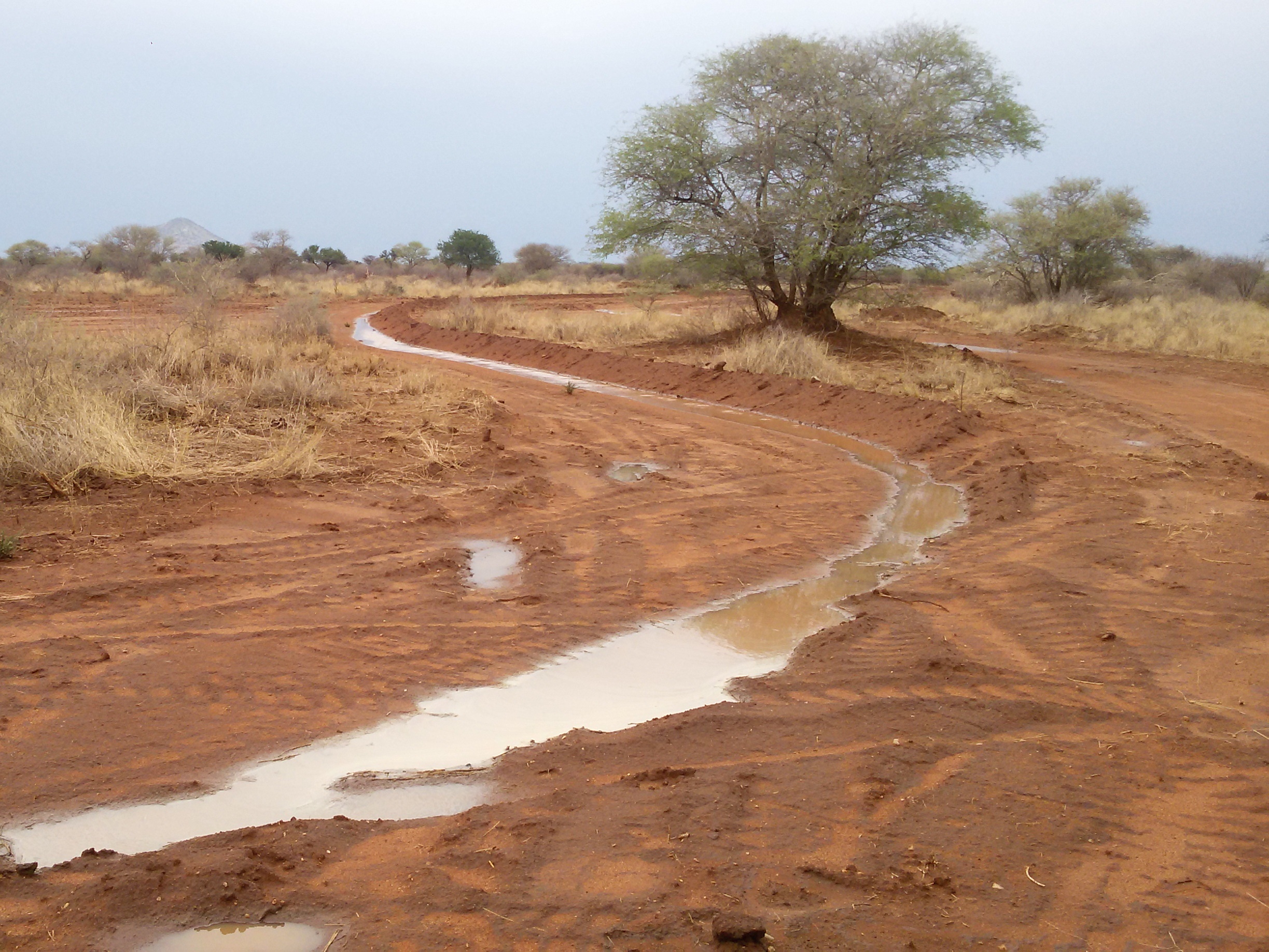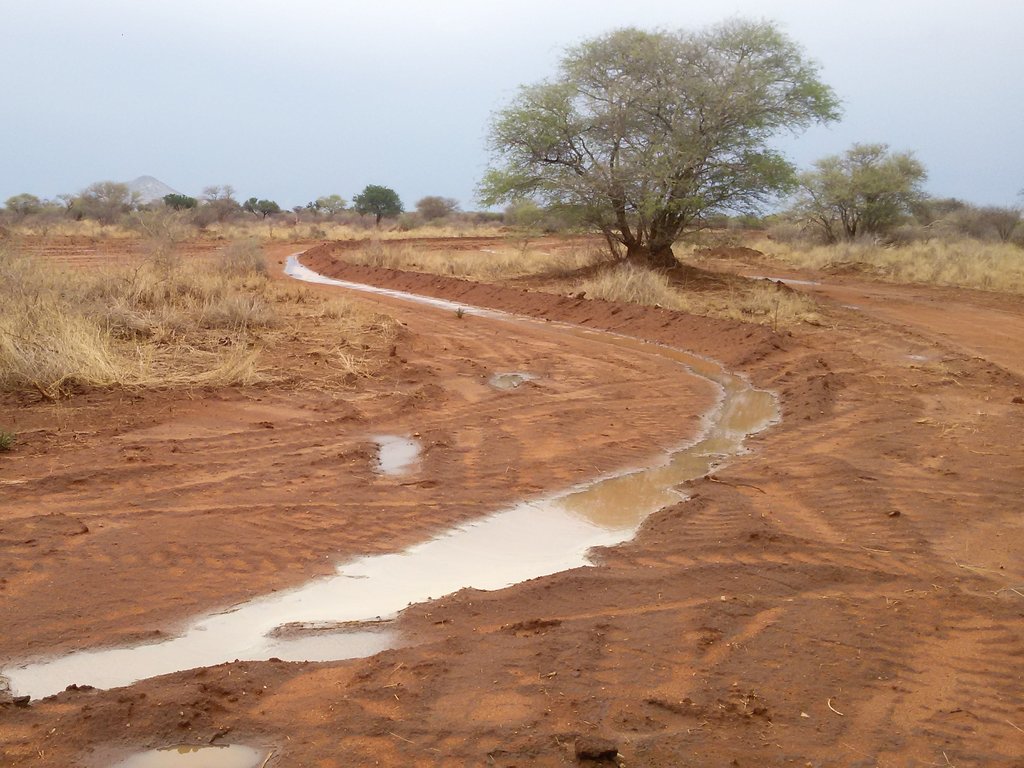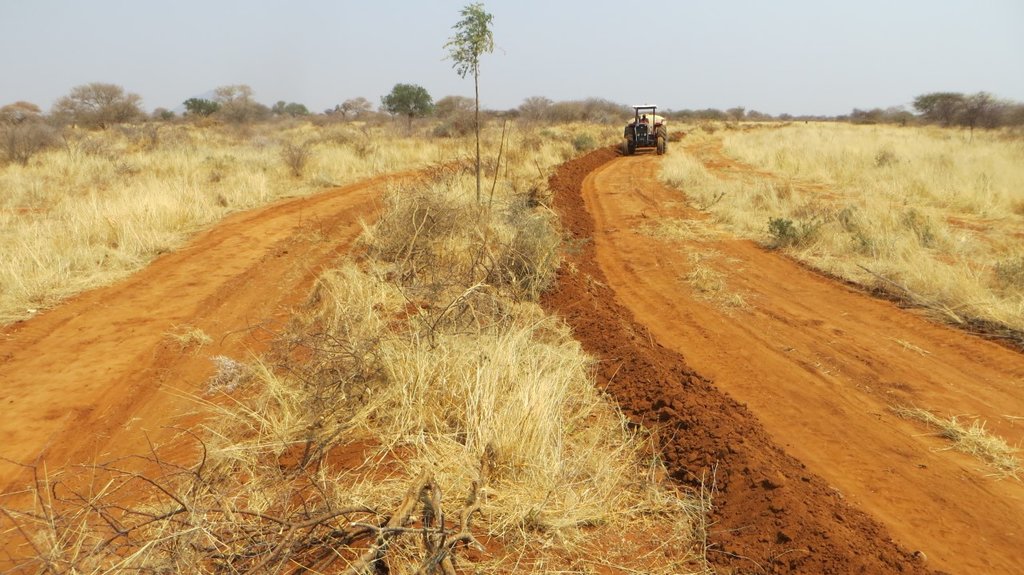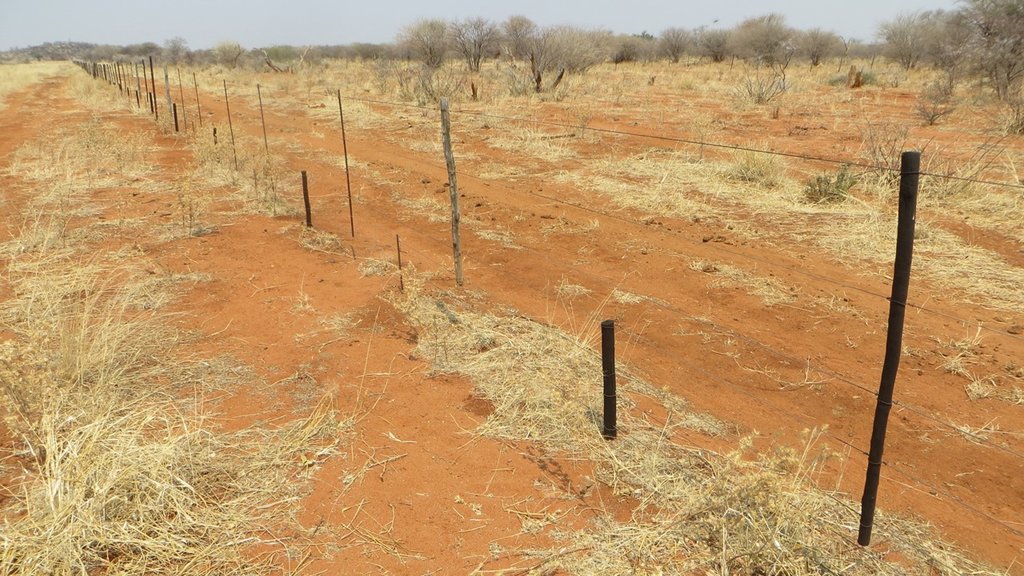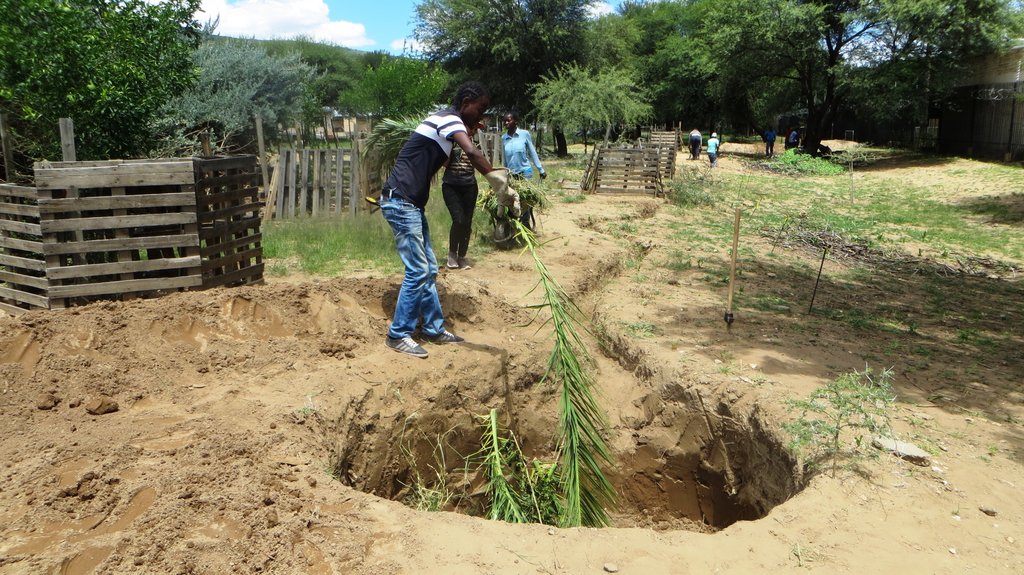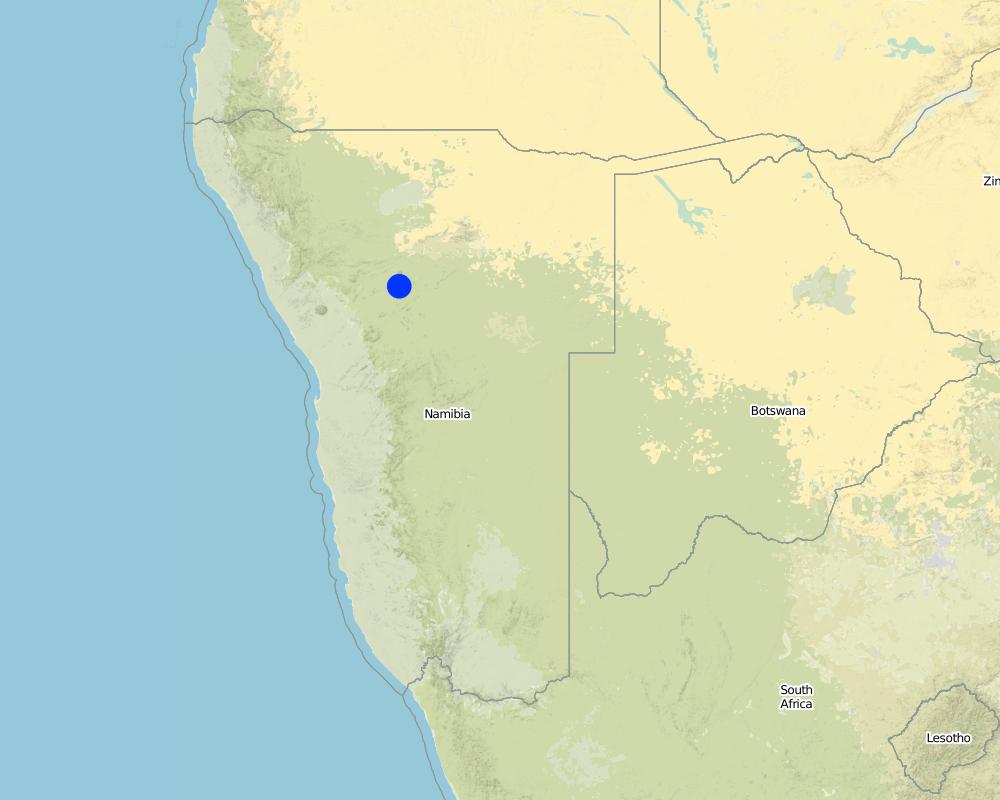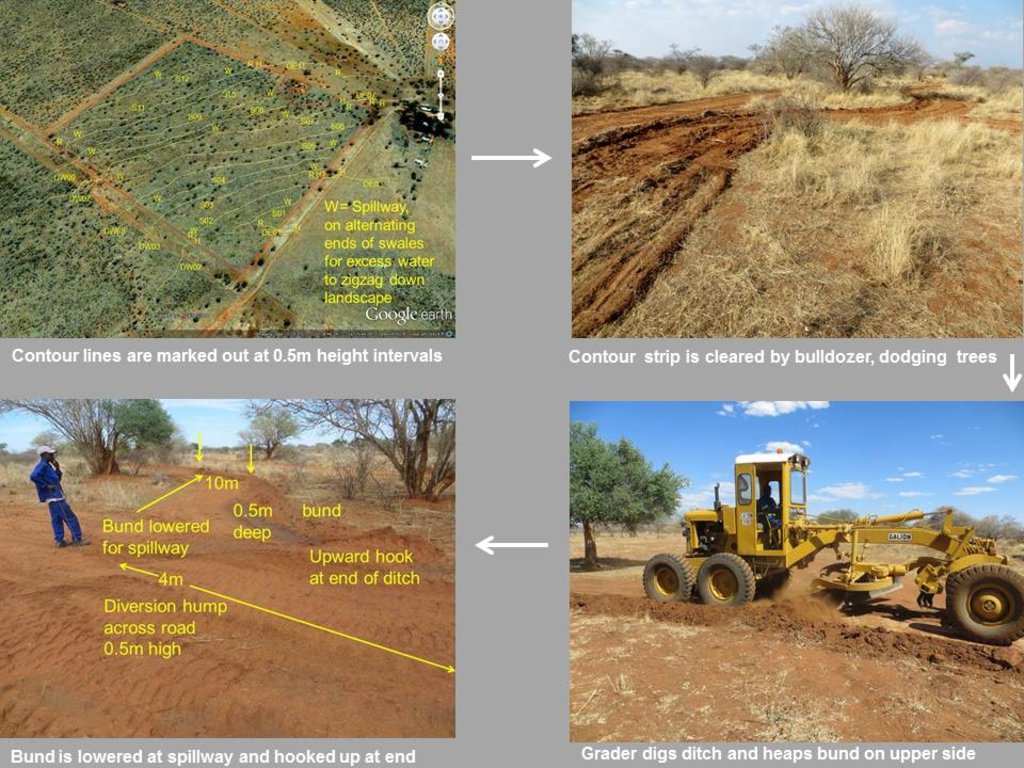Infiltration ditches and ponding banks [Namibie]
- Création :
- Mise à jour :
- Compilateur : Ibo Zimmermann
- Rédacteur : –
- Examinateur : Rima Mekdaschi Studer
Ovala
technologies_2989 - Namibie
Voir les sections
Développer tout Réduire tout1. Informations générales
1.2 Coordonnées des personnes-ressources et des institutions impliquées dans l'évaluation et la documentation de la Technologie
Personne(s)-ressource(s) clé(s)
exploitant des terres:
Kahl Uwe
+264 67 290004 / +264811486666
uwe2008@iway.na
Farm Middelplaats
P.O. Box 213 Otjiwarongo
Namibie
Spécialiste GDT:
Spécialiste GDT:
Pringle Hugh
+61 418415269
hpringle1@bigpond.com
Ecosystem Management Understanding
P.O. Box 8522 Alice Springs NT 0871
Australie
Nom du projet qui a facilité la documentation/ l'évaluation de la Technologie (si pertinent)
Southern African Science Service Centre for climate change and Adaptive Land management (SASSCAL)Nom du ou des institutions qui ont facilité la documentation/ l'évaluation de la Technologie (si pertinent)
Namibia University of Science and Technology ( NUST) - NamibieNom du ou des institutions qui ont facilité la documentation/ l'évaluation de la Technologie (si pertinent)
German Federal Ministry of Education and Research (BMBF) - Allemagne1.3 Conditions relatives à l'utilisation par WOCAT des données documentées
Quand les données ont-elles été compilées (sur le terrain)?
2017
Le compilateur et la(les) personne(s) ressource(s) acceptent les conditions relatives à l'utilisation par WOCAT des données documentées:
Oui
1.4 Déclaration sur la durabilité de la Technologie décrite
Est-ce que la Technologie décrite ici pose problème par rapport à la dégradation des terres, de telle sorte qu'elle ne peut pas être déclarée comme étant une technologie de gestion durable des terres?
Non
1.5 Référence au(x) questionnaire(s) sur les Approches de GDT
2. Description de la Technologie de GDT
2.1 Courte description de la Technologie
Définition de la Technologie:
Construction of contour ditches and ponding banks to trap and infiltrate rainwater for improved growth of plants and replenishment of ground water, while gently spilling any excess water safely over wide areas to avoid erosion during intense rain. It must be integrated with other technologies that treat the root causes of rangeland degradation rather than used as a stand-alone technology to treat symptoms.
2.2 Description détaillée de la Technologie
Description:
The technology is applied in rangeland where runoff occurs during and soon after rain, where the soil is deep enough to dig contour ditches and construct ponding banks, where there is sufficient gentle slope over a wide enough area for safely spilling excess water during intense rain, where valuable plants can establish themselves or be grown to benefit from the extra infiltrated rainwater, where the costs of earthmoving can soon be recovered through sale of extra production from the valuable plants and, most importantly, where the root causes of rangeland degradation have been addressed, usually through management of grazing and fires. At the appropriate area, contour lines are marked out by any available technology such as laser or dumpy level or mapped by drone. Where bushes grow densely, it may be necessary to clear narrow contour strips while leaving larger trees in place. Ditches can be dug to any depth down to approximately 50cm by mechanised grader or backhoe (a loader or digger attached to a tractor), or manually by pick and spade. The soil should ideally first be ripped where dug soil for the bund will be heaped, to ensure a firm foundation for the heaped soil to form a bund. To stabilise the bund, it should be compacted and creeping herbaceous plants should be encouraged to grow on it. Where water is to be spilled if ditches are full, either less soil needs to be heaped there or, if the ditch is deep enough, the natural ground surface can serve as spillway by avoiding to heap soil on it. In situations where excess water can safely be spilled from outward curves of the down-slope side of a long ditch, the dug soil can be placed as a bund below the long sections of ditch where water does not need to spill. In situations where excess water should rather be spilled evenly over the whole length of ditch, then either a second ditch can be graded below the first ditch, with the dug soil heaped upslope, or all of the dug soil needs to be moved and put to use elsewhere. Such soil could be used for building humps to divert flowing water out of tracks and back into natural flow paths, or to construct banks that divert water flowing down shallow gullies into contour ditches. Since it is almost impossible to dig exactly on contour, water starts to spill over the slightly lower edges of the ditch before the volume of water flow increases sufficiently to spill over the whole edge of the ditch. This results in self reinforcement over successive rainfall periods because herbaceous plants grow more densely at the slightly lower edges due to the greater amount of water that previously spilled there, resulting in more sediment being trapped there and consequent raising of the soil level, also by puffing up of the soil from their root growth and exudates which feed soil organisms. Eventually the previously lower sections are raised higher than other sections of the ditch edge, where subsequent spills wet the soil more for denser plant growth, and this slow self-reinforcing effect continues indefinitely. To avoid spillage over the end of each ditch, a short upward curve is built in when digging the ditch and heaping the bund. Organic material can also be placed in the ditch, or in larger settling ponds along the ditch, to improve nutrient cycling. Infiltration ditches were constructed at intervals of 0.5m height on a 30ha densely bushed portion of Farm Middleplaats and trees were planted below the ditches to grow into a fruitful landscape. Species included large canopy trees such as Faidherbia albida and Acacia erioloba, shorter thornless trees for “chop and drop” mulching, such as Peltophorum africanum and Bolusanthus speciosus, and trees that produce fruits, such as Sclerocarya birrea and Berchemia discolor, or edible leaves, such as Moringa oleifera. The tree seedlings were raised in a nursery on the farm, and he fence around the 30ha had to be strengthened to protect the planted seedlings from oryx. In addition, it was necessary to water the seedlings in the landscape for the first year or two until well established, On another portion of the farm where bushes had previously been cleared and the soil was consequently less fertile, ponding banks of approximately 1m height were constructed, especially in locations where it appeared that water had ponded naturally in the past. The ponded water encourages growth of herbaceous plants, especially where soil is scraped from below the bank so that the soil on its upper side remains undisturbed. A few grasses were dug from a wetland and brought to the farm for later transplanting of propagules into the ponded areas.
2.3 Photos de la Technologie
2.4 Vidéos de la Technologie
Commentaire, brève description:
https://www.youtube.com/watch?v=6C4V_Cib8ts
Only a short section in the film from 18m07s to 19m15s
Date:
08/04/2015
Lieu:
Farm Middelplaats and KAYEC campus, both in Namibia
Nom du vidéaste:
Andrew Botelle
2.5 Pays/ région/ lieux où la Technologie a été appliquée et qui sont couverts par cette évaluation
Pays:
Namibie
Région/ Etat/ Province:
Otjozondjupa and Khomas Retions
Map
×2.6 Date de mise en œuvre de la Technologie
Indiquez l'année de mise en œuvre:
2014
2.7 Introduction de la Technologie
Spécifiez comment la Technologie a été introduite: :
- par le biais de projets/ d'interventions extérieures
Commentaires (type de projet, etc.) :
Projects involving students
3. Classification de la Technologie de GDT
3.1 Principal(aux) objectif(s) de la Technologie
- améliorer la production
- réduire, prévenir, restaurer les terres dégradées
- conserver/ améliorer la biodiversité
- créer un impact économique positif
3.2 Type(s) actuel(s) d'utilisation des terres, là où la Technologie est appliquée

Pâturages
Pâturage extensif:
- Ranching
Principales espèces animales et principaux produits:
Beef cattle and game animals
3.3 Informations complémentaires sur l'utilisation des terres
Approvisionnement en eau des terres sur lesquelles est appliquée la Technologie:
- pluvial
Commentaires:
Except for Initial watering of planted tree seedlings, which was necessitated by drought
Nombre de période de croissance par an: :
- 1
Densité d'élevage/ chargement (si pertinent):
10ha/LSU averaged out over time and not continuous
3.4 Groupe de GDT auquel appartient la Technologie
- agroforesterie
- pastoralisme et gestion des pâturages
- récupération/ collecte de l'eau
3.5 Diffusion de la Technologie
Spécifiez la diffusion de la Technologie:
- répartie uniformément sur une zone
Si la Technologie est uniformément répartie sur une zone, indiquez la superficie couverte approximative:
- 0,1-1 km2
3.6 Mesures de GDT constituant la Technologie

pratiques végétales
- V1: Couverture d’arbres et d’arbustes
- V2: Herbes et plantes herbacées pérennes
- V3: Défrichement de la végétation

structures physiques
- S2: Diguettes, digues
- S4: Fossés isohypses, trous

modes de gestion
- M2: Changement du niveau de gestion / d'intensification
- M5: Contrôle/ changement de la composition des espèces
3.7 Principaux types de dégradation des terres traités par la Technologie

érosion hydrique des sols
- Wt: perte de la couche superficielle des sols (couche arable)/ érosion de surface
- Wg: ravinement/ érosion en ravines

dégradation hydrique
- Hg: changement du niveau des nappes phréatiques (eaux souterraines) et des aquifères
3.8 Prévention, réduction de la dégradation ou réhabilitation des terres dégradées
Spécifiez l'objectif de la Technologie au regard de la dégradation des terres:
- prévenir la dégradation des terres
- restaurer/ réhabiliter des terres sévèrement dégradées
4. Spécifications techniques, activités, intrants et coûts de mise en œuvre
4.1 Dessin technique de la Technologie
4.2 Spécification/ explications techniques du dessin technique
Contour strips were cleared by bulldozer at 0.5m height intervals on land with a gradient of approximately 1:100. A line was ripped approximately 0.6m deep, over which soil was heaped for a bund by a grader when digging a ditch on its upper side to hold rainwater at a depth of approximately 0.5m. The ends were hooked upwards by approximately 2m to avoid spillage there, while spillways were created by lowering a 10m length of the bund and staggered between ditches to zig-zag the spilled water slowly down the landscape. A variety of tree seedlings were planted below ditches to provide tall canopies, chop-and-drop mulching and edible leaves or fruits, at intervals of approximately 5m.
4.3 Informations générales sur le calcul des intrants et des coûts
Spécifiez la manière dont les coûts et les intrants ont été calculés:
- par superficie de la Technologie
Indiquez la taille et l'unité de surface:
30ha (contour ditches only)
autre/ monnaie nationale (précisez):
NAD
Indiquez le coût salarial moyen de la main d'œuvre par jour:
72 NAD
4.4 Activités de mise en place/ d'établissement
| Activité | Type de mesures | Calendrier | |
|---|---|---|---|
| 1. | Marking of contour lines | Structurel | Dry season |
| 2. | Clearing of bush strips along contour | Structurel | Dry season |
| 3. | Ripping along contour | Structurel | Dry season |
| 4. | Digging ditch and heaping bund over ripline | Structurel | Start of rains |
| 5. | Raising tree seedlings in nursery | Végétale | Mostly dry season |
| 6. | Planting tree seedlings below ditches | Végétale | Rainy season |
| 7. | Watering tree seedlings | Végétale | Dry season |
| 8. | Strengthening fence around landscape to exclude oryx | Structurel | When needed |
4.5 Coûts et intrants nécessaires à la mise en place
| Spécifiez les intrants | Unité | Quantité | Coûts par unité | Coût total par intrant | % des coût supporté par les exploitants des terres | |
|---|---|---|---|---|---|---|
| Main d'œuvre | Marking of contour lines | Person days | 6,0 | 72,0 | 432,0 | 100,0 |
| Main d'œuvre | Raising tree seedlings in nursery | Person days | 20,0 | 72,0 | 1440,0 | 100,0 |
| Main d'œuvre | Planting tree seedlings below ditches | Person days | 10,0 | 72,0 | 720,0 | 100,0 |
| Main d'œuvre | Watering every 10 days in first year, except after rain | Person days | 150,0 | 72,0 | 10800,0 | 100,0 |
| Equipements | Strengthening fence to exclude oryx (Labour) | Person days | 100,0 | 72,0 | 7200,0 | 100,0 |
| Equipements | Bulldozer to clear strips and rip | Bulldozer hours | 89,0 | 850,0 | 75650,0 | 100,0 |
| Equipements | Grader to dig ditches and heap bunds | Grader hours | 35,0 | 650,0 | 22750,0 | 100,0 |
| Equipements | Diesel for bulldozer and grader | Litres | 1000,0 | 12,0 | 12000,0 | 100,0 |
| Equipements | Tractor & 7000 lt water trailer every 10 days in first year, except after rain | Tractor days | 30,0 | 1250,0 | 37500,0 | 100,0 |
| Matériel végétal | 500 Plastic bags / seeds with soil to raise seedllngs | Filled growing bags | 500,0 | 4,0 | 2000,0 | 100,0 |
| Matériaux de construction | Fencing wire and posts to strengthen fence around fruitful landscape | km of fencing | 3,0 | 2200,0 | 6600,0 | 100,0 |
| Coût total de mise en place de la Technologie | 177092,0 | |||||
4.6 Activités d'entretien/ récurrentes
| Activité | Type de mesures | Calendrier/ fréquence | |
|---|---|---|---|
| 1. | Maintenance of ditches and bunds by grader | Structurel | Rainy season |
4.7 Coûts et intrants nécessaires aux activités d'entretien/ récurrentes (par an)
| Spécifiez les intrants | Unité | Quantité | Coûts par unité | Coût total par intrant | % des coût supporté par les exploitants des terres | |
|---|---|---|---|---|---|---|
| Equipements | Grader cost to maintain the swales every 3 – 4 years | Grader hours | 8,0 | 700,0 | 5600,0 | 100,0 |
| Coût total d'entretien de la Technologie | 5600,0 | |||||
4.8 Facteurs les plus importants affectant les coûts
Décrivez les facteurs les plus importants affectant les coûts :
High cost of hiring or operating earthmoving machinery
5. Environnement naturel et humain
5.1 Climat
Précipitations annuelles
- < 250 mm
- 251-500 mm
- 501-750 mm
- 751-1000 mm
- 1001-1500 mm
- 1501-2000 mm
- 2001-3000 mm
- 3001-4000 mm
- > 4000 mm
Spécifications/ commentaires sur les précipitations:
A single summer rainfall period over approximately four months per year
Indiquez le nom de la station météorologique de référence considérée:
Otjiwarongo
Zone agro-climatique
- semi-aride
5.2 Topographie
Pentes moyennes:
- plat (0-2 %)
- faible (3-5%)
- modéré (6-10%)
- onduleux (11-15%)
- vallonné (16-30%)
- raide (31-60%)
- très raide (>60%)
Reliefs:
- plateaux/ plaines
- crêtes
- flancs/ pentes de montagne
- flancs/ pentes de colline
- piémonts/ glacis (bas de pente)
- fonds de vallée/bas-fonds
Zones altitudinales:
- 0-100 m
- 101-500 m
- 501-1000 m
- 1001-1500 m
- 1501-2000 m
- 2001-2500 m
- 2501-3000 m
- 3001-4000 m
- > 4000 m
Indiquez si la Technologie est spécifiquement appliquée dans des:
- non pertinent
Commentaires et précisions supplémentaires sur la topographie:
Scattered rocky outcrops
5.3 Sols
Profondeur moyenne du sol:
- très superficiel (0-20 cm)
- superficiel (21-50 cm)
- modérément profond (51-80 cm)
- profond (81-120 cm)
- très profond (>120 cm)
Texture du sol (de la couche arable):
- grossier/ léger (sablonneux)
Texture du sol (> 20 cm sous la surface):
- grossier/ léger (sablonneux)
Matière organique de la couche arable:
- faible (<1%)
Si disponible, joignez une description complète du sol ou précisez les informations disponibles, par ex., type de sol, pH/ acidité du sol, capacité d'échange cationique, azote, salinité, etc.
A calcrete layer is occasionally exposed at the soil surfacce
5.4 Disponibilité et qualité de l'eau
Profondeur estimée de l’eau dans le sol:
5-50 m
Disponibilité de l’eau de surface:
faible/ absente
Qualité de l’eau (non traitée):
faiblement potable (traitement nécessaire)
La salinité de l'eau est-elle un problème? :
Oui
Précisez:
The water is only slightly brackish
La zone est-elle inondée?
Non
5.5 Biodiversité
Diversité des espèces:
- moyenne
Diversité des habitats:
- moyenne
5.6 Caractéristiques des exploitants des terres appliquant la Technologie
Sédentaire ou nomade:
- Sédentaire
Orientation du système de production:
- commercial/ de marché
Revenus hors exploitation:
- 10-50% de tous les revenus
Niveau relatif de richesse:
- moyen
Individus ou groupes:
- individu/ ménage
Niveau de mécanisation:
- travail manuel
- mécanisé/ motorisé
Genre:
- femmes
- hommes
Age des exploitants des terres:
- personnes d'âge moyen
5.7 Superficie moyenne des terres détenues ou louées par les exploitants appliquant la Technologie
- < 0,5 ha
- 0,5-1 ha
- 1-2 ha
- 2-5 ha
- 5-15 ha
- 15-50 ha
- 50-100 ha
- 100-500 ha
- 500-1 000 ha
- 1 000-10 000 ha
- > 10 000 ha
Cette superficie est-elle considérée comme de petite, moyenne ou grande dimension (en se référant au contexte local)?
- grande dimension
5.8 Propriété foncière, droits d’utilisation des terres et de l'eau
Propriété foncière:
- individu, avec titre de propriété
Droits d’utilisation des terres:
- individuel
Droits d’utilisation de l’eau:
- individuel
5.9 Accès aux services et aux infrastructures
santé:
- pauvre
- modéré
- bonne
éducation:
- pauvre
- modéré
- bonne
assistance technique:
- pauvre
- modéré
- bonne
emploi (par ex. hors exploitation):
- pauvre
- modéré
- bonne
marchés:
- pauvre
- modéré
- bonne
énergie:
- pauvre
- modéré
- bonne
routes et transports:
- pauvre
- modéré
- bonne
eau potable et assainissement:
- pauvre
- modéré
- bonne
services financiers:
- pauvre
- modéré
- bonne
6. Impacts et conclusions
6.1 Impacts sur site que la Technologie a montrés
Impacts socio-économiques
Production
production fourragère
Commentaires/ spécifiez:
Mainly Moringa oleifera
qualité des fourrages
Commentaires/ spécifiez:
Moringa leaves
production animale
Commentaires/ spécifiez:
Moringa heavily browsed
production forestière non ligneuse
Commentaires/ spécifiez:
Still saplings
diversité des produits
Commentaires/ spécifiez:
Moringa leaves and fruits of other species could be harvested
Disponibilité et qualité de l'eau
disponibilité de l'eau pour l'élevage
Commentaires/ spécifiez:
Livestock need less water after feeding on lush forage
Revenus et coûts
dépenses pour les intrants agricoles
Commentaires/ spécifiez:
High initial cost of earthmoving
diversité des sources de revenus
Commentaires/ spécifiez:
Potential from Moringa
charge de travail
Commentaires/ spécifiez:
To water saplings
Impacts socioculturels
sécurité alimentaire/ autosuffisance
Commentaires/ spécifiez:
Nutritious Moringa leaves may be added to diets
situation sanitaire
Commentaires/ spécifiez:
If nutritious Moringa leaves are eaten
connaissances sur la GDT/ dégradation des terres
Commentaires/ spécifiez:
Learning from action research
Impacts écologiques
Cycle de l'eau/ ruissellement
ruissellement de surface
Commentaires/ spécifiez:
Slowed, spread and infiltrated by ditches and ponds
nappes phréatiques/ aquifères
Commentaires/ spécifiez:
From improved infiltration
Sols
humidité du sol
Commentaires/ spécifiez:
Near ditches and banks
couverture du sol
Commentaires/ spécifiez:
In ditches and ponds
cycle/ recharge des éléments nutritifs
Commentaires/ spécifiez:
Below ditches and ponds
matière organique du sol/ au dessous du sol C
Commentaires/ spécifiez:
Through tree and grass roots
Biodiversité: végétale, animale
Couverture végétale
Commentaires/ spécifiez:
In ditches and ponds
biomasse/ au dessus du sol C
Commentaires/ spécifiez:
In ditches and ponds
diversité végétale
Commentaires/ spécifiez:
In ditches and ponds
diversité des habitats
Commentaires/ spécifiez:
Along ditches and ponds
Réduction des risques de catastrophe et des risques climatiques
impacts de la sécheresse
Commentaires/ spécifiez:
Along ditches and ponds
risques d'incendies
Commentaires/ spécifiez:
Along ditches and ponds, due to increased grass
6.2 Impacts hors site que la Technologie a montrés
inondations en aval
Commentaires/ spécifiez:
Through improved infiltration on the farm
6.3 Exposition et sensibilité de la Technologie aux changements progressifs et aux évènements extrêmes/catastrophes liés au climat (telles que perçues par les exploitants des terres)
Changements climatiques progressifs
Changements climatiques progressifs
| Saison | Type de changements/ extrêmes climatiques | Comment la Technologie fait-elle face à cela? | |
|---|---|---|---|
| autre changement climatique progressif | Increased variability in temperature and rainfall | augmente | bien |
Extrêmes climatiques (catastrophes)
Catastrophes météorologiques
| Comment la Technologie fait-elle face à cela? | |
|---|---|
| pluie torrentielle locale | bien |
| orage local | bien |
Catastrophes climatiques
| Comment la Technologie fait-elle face à cela? | |
|---|---|
| canicule | bien |
| vague de froid | bien |
| sécheresse | bien |
| feu de végétation | modérément |
Catastrophes hydrologiques
| Comment la Technologie fait-elle face à cela? | |
|---|---|
| crue éclair | bien |
Catastrophes biologiques
| Comment la Technologie fait-elle face à cela? | |
|---|---|
| infestation par des insectes/ vers | bien |
Autres conséquences liées au climat
Autres conséquences liées au climat
| Comment la Technologie fait-elle face à cela? | |
|---|---|
| réduction de la période de croissance | bien |
6.4 Analyse coûts-bénéfices
Quels sont les bénéfices comparativement aux coûts de mise en place (du point de vue des exploitants des terres)?
Rentabilité à court terme:
négative
Rentabilité à long terme:
positive
Quels sont les bénéfices comparativement aux coûts d'entretien récurrents (du point de vue des exploitants des terres)?
Rentabilité à court terme:
légèrement négative
Rentabilité à long terme:
positive
6.5 Adoption de la Technologie
- cas isolés/ expérimentaux
Parmi tous ceux qui ont adopté la Technologie, combien d'entre eux l'ont fait spontanément, à savoir sans recevoir aucune incitation matérielle ou aucun paiement?
- 0-10%
6.6 Adaptation
La Technologie a-t-elle été récemment modifiée pour s'adapter à l'évolution des conditions?
Oui
Si oui, indiquez à quel changement la Technologie s'est adaptée:
- changements/ extrêmes climatiques
Spécifiez l'adaptation de la Technologie (conception, matériaux/ espèces, etc.):
After noticing death of tree seedlings from extreme drought, the decision was taken to irrigate them until sufficiently well established to care for themselves.
6.7 Points forts/ avantages/ possibilités de la Technologie
| Points forts/ avantages/ possibilités du point de vue de l'exploitant des terres |
|---|
| Avoids wastage of rainwater lost as runoff from the farm and puts it to good use on the farm. |
| Points forts/ avantages/ possibilités du point de vue du compilateur ou d'une autre personne ressource clé |
|---|
| Improved water and nutrient cycling, resulting in better plant growth and higher animal production. |
| Reduced erosion of soil |
6.8 Faiblesses/ inconvénients/ risques de la Technologie et moyens de les surmonter
| Faiblesses/ inconvénients/ risques du point de vue de l’exploitant des terres | Comment peuvent-ils être surmontés? |
|---|---|
| Death of many tree seedlings | By irrigating tree seedlings until they are sufficiently well established to care for themselves, which may take one or two years. |
| Faiblesses/ inconvénients/ risques du point de vue du compilateur ou d'une autre personne ressource clé | Comment peuvent-ils être surmontés? |
|---|---|
| High cost of earthmoving | Growing of high value plants to recoup costs as quickly as possible, such as Moringa and dates. |
7. Références et liens
7.1 Méthodes/ sources d'information
- visites de terrain, enquêtes sur le terrain
- interviews/entretiens avec les exploitants des terres
7.2 Références des publications disponibles
Titre, auteur, année, ISBN:
Rainwater harvesting for drylands and beyond: Vol 2 – Water-harvesting earthworks, Lancaster, 0-977-246418
Disponible à partir d'où? Coût?
https://www.amazon.com/Rainwater-Harvesting-Drylands-Beyond-Vol/dp/0977246418 $28
7.3 Liens vers les informations pertinentes disponibles en ligne
Titre/ description:
Planning and managing farm roads Manual
URL:
www.sasscal.org/downloads/Planning_and_managing_farm_roads_in_Namibia.pdf
Titre/ description:
Rangeland Rehydration Field Guide
URL:
https://emulandrecovery.org.au/~emulandr/files/Rangeland-Rehydration-Field-Guide.pdf
Liens et modules
Développer tout Réduire toutLiens
Aucun lien
Modules
Aucun module trouvé


